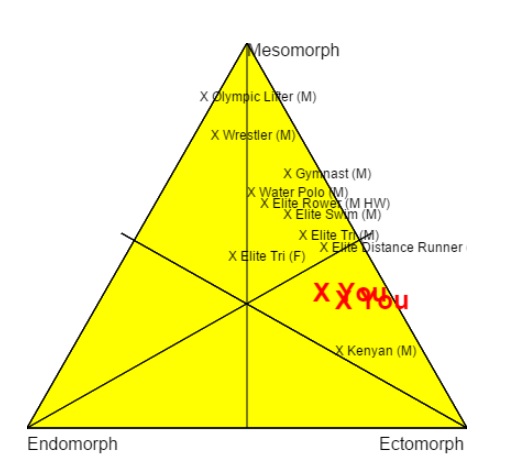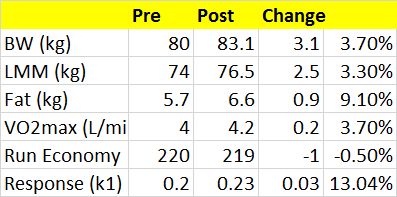Big Steel Challenge 2016: A Case Study
Alan Couzens, M.S. (Sports Science)
Jan 20th, 2016

Michelangelo’s David: Somatotype 1.0-7.5-2.0 (Bok, 1976) took an estimated 10,000 hours to sculpt!
Message: Keep on chipping away! :-)
The EC team recently completed our 6th Annual Big Steel Challenge. It was another successful year, with the team, as a whole moving more than 2 million pounds over the month of December.
While the usual insanity was a little more moderate this year, there were still some very impressive individual performances as well. EC Pro triathlete, Justin Daerr put up almost 450,000lbs at over 650lbs/min. You can read Justin’s thoughts here.
In a previous post, I looked at some of the objectives of our strength emphasis month(s) – namely to build a body that is more generally athletic (which also tends to lead to a body that responds better to specific training – one of the key tenets of periodization). While the total load numbers are fun to track, a large part of determining the 'success' of a strength volume block comes down to assessing these changes in the athlete’s body comp/somatotype.
A move up the somatotype triangle for most aging athletes is a very positive thing! Working against Father Time’s tendency to strip us of just a little bit of lean muscle each and every year is a worthy goal on a lot of levels. There aren’t a lot of mesomorphs running around in the 60+ AG’s! If you’re of the more naturally ectomorphic persuasion to begin with, the importance of making this a key objective each & every year is greater still.
As I’ve said previously, for the above reasons, I’m a big fan of monitoring an athlete's body comp over time. Things like DEXA testing & anthropometry provide an important adjunct to the more commonly implemented physiological tests. Even though, for obvious reasons, looking at things like rising body fat & muscle wastage tends to be less appealing :-) While I could offer some very interesting case studies on how athlete body comp changes over time in response to different training systems, I’ve a sense that throwing my athletes’ DEXA scans and bodyfat numbers around on the World Wide Web might not be a great move for athlete retention ;-) So, for this one, you’re stuck with my less interesting (though hopefully still educational) numbers…
I present the below in the hope that it will offer coaches and athletes an example of a healthier, more individualized & more performance oriented means of setting body comp targets and training interventions to achieve said targets than the all too common 'don't strength train - muscle is just extra weight to lug around' & ‘make sure the cupboards are bare because skinnier is better’. So, without further ado, let's dissect AC!….
I was happy with my own ‘input’ numbers for this year’s Big Steel block - even though a little less impressive than the guys at the top of the leader board: 258,898lbs @ 513lbs/min – about 75% of the top guys outputs – a similar percentage to my Ironman power output when compared to Justin’s. I wonder if that relationship is coincidental? If you’ve read my previous post on the importance of strength to endurance, you know my position – it’s not! :-)
Although not quite on par with my younger, more mesomorphic brothers, this was my highest total to date and my first year over 500lbs/min. With the normal tendencies as age creeps up, I consider any year of lifting more than the last a definite win! And it wasn’t just the load numbers that left me satisfied…
Thankfully (& purposefully) this load input led to me coming out of this year’s Big Steel with a body comp a little less ectomorphic than I went in & a little closer to athletic norms. By using the somatotype calculator that I provided in a previous post, you can see my ‘before and after’ Somatotype on the chart below, with a small but still significant 'North-westerly' shift away from the ectomorphy corner and towards mesomorphy after a 4 week focused block of lifting and eating.

Specifically, the numbers moved from 1.9-3.2-4.3 to 2.1-3.3-3.9. Still a ways from the typical elite numbers of 1.6/4.2/3.0 that I referenced in that post, but a step in the right direction. In ‘real world’ terms, this amounted to a total weight gain of 7 lbs, with 5 lbs ‘lean’ and + 2 lbs bodyfat (as assessed by skinfolds – 42mm-50mm for sum of 6). An important note if using DEXA to assess changes in body comp, fat numbers will be higher (by~a factor of 2) and lean numbers lower as DEXA adds in changes in visceral fat as well as the subcutaneous fat (as measured by skinfolds) in its assessment.
Just as importantly, pre and post tests for VO2max (shown in the table below)..

….confirm that the muscle added was aerobic in quality. This is a crucial sub goal in strength training for endurance athletes that I talked about here. To confirm that any mass added is aerobically useful, we should see absolute VO2 max go up, not down, following a well planned strength block (& relative VO2max at least maintained). I did VO2 testing before and post strength block to assess this and was pleased to see an increase in absolute VO2 max that went along with the increase in absolute LMM. If we see an increase in LMM with a drop in VO2max, it is, in my mind a good indication that the type of strength training (often traditional hypertrophy training) was inappropriate for the endurance athlete.
All in all, some positive shifts. But I’ve broken scientific convention here a bit by placing the results before the method, so what method specifics led to these results?
Nutrition…
- Caloric surplus – Mean caloric intake for the month was 3725 kcal/day – an average surplus of 581kcal/day (after subtracting RMR & daily activity).
- High protein intake – Protein intake was 151g/day (1.8g/kg). The bulk came from lean meat (~40g/meal – as normal) but I also added 30g of Whey powder after each strength session
- Moderate carb - ~40/20/40% to maintain an optimal (anabolic) hormonal balance & avoid excessive CHO consumption with reduced overall training load
These protein and calorie numbers were a little lower than I’ve done in past years (2g/kg/day of protein, ~40/30/30 and 1000kcal+/day surplus) & weight/LMM gain was slightly lower than previous years but this nutritional change was noticeably less stressful on the system than eating a pound of meat at each meal!
Training...
- Lower than normal SBR volumes but still sufficient to maintain aerobic base – Typical day was 90min training – 30 strength + 60 low intensity aerobic. On a number of days, legs were too tired for an aerobic mainset at >AeT but if too tired to jog or swim with good form, I cut back on the strength. The strength workouts represented the ‘main sets’ of my loading days.
- Frequent strength work of short duration & mixed intensity (to hit all fibers and keep anabolic response high). Both Justin’s (top) & my (bottom) loading pattern for the block are shown below…


A few things are clear….
- Justin can throw around a lot of steel in a short period of time for a guy whose event is 8hrs in duration! :-)
- We both accomplished relatively high load volume by lifting short & frequent – 20 sessions for myself over the month & 21 for Justin.
- There was a good bit of variation in volume and intensity. Something I talked about in my last post, with Easy sessions (300-600lbs/min), ‘Aerobic Strength’ sessions (500-800lbs/min) with a few of them w/big session loads (30,000+ for J, 25,000+ for me) & a few max strength ‘special efforts’ (often of lower volume) at 700-900/1000-1200 lbs/min resp.
Some examples of each of these from my facebook posts on the Big Steel group page are given below…
Max Strength: "Bit short on time so just a little one. Tried to make up for it with some intensity... Back squat – (45/20, 95/10, 135/5) x 2. Overhead Press – (45/20, 55/10, 70/5) x 2. Top numbers were currently a bit much for perfect form but gave the nervous system a nice little wake up"
Aerobic Strength (BIG): "Cabin fever may be setting in... Session 12: '12 days of Xmas' workout - 70/1 OH Press, 70/2 Push Press, 3 Pull Up, 70/4 Split Squat, 70/5 Bent-over Row, 70/6 Front Squat, 70/7 Flat Press, 70/8 Lunge Walk, 9 Push Ups, 35/10RL Calf raise, 70/11 Deadlift, 12 SL Bridge... Done in traditional fashion "On the 1st day of Xmas my strength coach gave to me 1 overhead press...on the 2nd day...2 push presses & 1 overhead press..." Like a compound interest problem, longer & more tiring than expected (28820lbs/58min)"
Easy Strength: “12 days of Xmas' leaving a mark so just a light 'tonic' session today: Lots of SMR, some rotator cuff work with the band then (20/10 Romanian Deadlift against wall -> Upright Row + 10 Spiderman Push Ups) x 10 @ 2:00"
As you can probably tell, while the objectives of the block are 100% serious & represent a good chunk of work and a good few days of "constant-onset muscle soreness" (as coined by @FeWoman :-) the variety that strength work brings to the training makes this break from the endurance athletes regular SBR milieu one of the most fun blocks of the training year!
In summary, body composition – both the muscle and fat sides of the equation are an important part of both training response and your level of performance in a specific event. Small shifts can have a large impact on both. For this reason, it is important to monitor an athlete's body comp on an ongoing basis and make intelligent 'course corrections' where needed. However, making these changes is not an easy or short term proposition & can best be thought of as akin to a sculptor working with a piece of stone – keep chipping away year after year, shaping as you go, with your vision firmly in mind and the end result will be a lasting masterpiece.
Train smart,
AC
TweetDon't miss a post! Sign up for my mailing list to get notified of all new content....
